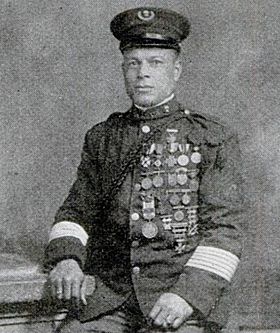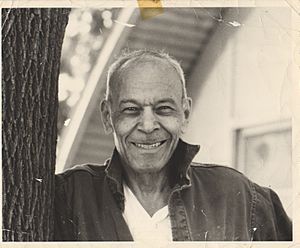Lewis Broadus facts for kids
Quick facts for kids
Captain
Lewis Broadus
|
|
|---|---|

Lewis Broadus
(in The Crisis Magazine, June 1917) |
|
| Birth name | Louis Cunningham |
| Nickname(s) | "Cap" |
| Born | July 24, 1877 Henrico County, Virginia, U.S. |
| Died | June 23, 1961 (aged 83) Jamaica, Queens, U.S. |
| Buried | |
| Allegiance | |
| Service/ |
|
| Years of service | 1897–1923 |
| Rank | |
| Unit | 25th Infantry Regiment |
| Battles/wars | |
| Awards | |
| Spouse(s) |
Florence Blackwood
(m. 1897)Edith McClenny
(m. 1931) |
| Other work | Special Officer, Mount Vernon PD Alcohol Tax Division, New York City |
Captain Lewis Cunningham Broadus (1877–1961) was a Buffalo Soldier born in Henrico County, Virginia, who served his country with distinction in the 25th Infantry Regiment and the 92nd Division of the United States Army. He served from 1897 to 1923, and was a veteran of the Indian Wars, Spanish–American War, Philippine–American War, Border War, and World War I.
He began his military career as a Private in Company D, 25th Infantry Regiment. Over the course of the many military campaigns he participated in, Lewis rose through the ranks, reaching the highest enlisted rank of his regiment, Sergeant Major. With the outbreak of World War I, and after many petitions and commendations, he attend officer training and was successfully commissioned as a Captain in 1917.
Lewis was awarded a Certificate of Merit for "coolness, presence of mind, and bravery in saving lives of others at Fort Niobrara," by President Theodore Roosevelt in 1906. After the Certificate of Merit Medal was declared obsolete in 1918, his medal was first exchanged for the newly established Distinguished Service Medal, and, after a change in award regulations by Congress in 1934, converted into the Distinguished Service Cross.
Contents
Background and personal life
Born on July 24, 1877, in Richmond, Virginia, he was the son of an Irish slave owner, Louis Cunningham, and an enslaved African woman, who today is known only as Lizzie. He appears in the U.S. Census dated June 3, 1880, Henrico County, Virginia, as Louis Cunningham, age three. After the untimely death of his mother, he was raised by the Broadus family, listed in the census as "Arthur- stable hand", his son "David- tobacco hand", and daughter "Mary- washerwoman". He later changed his name to Lewis Broadus.
While stationed at Fort Custer, Montana, he met and married Florence Blackwood, a young Native American woman of the Lakota (Sioux) born of the Burnt Thigh Tiyošpaye Band, which was later named the Rosebud Sioux, during the time period when the Dakota Territory became the State of South Dakota. After marrying, Lewis decided to make the U.S. Army his career, which involved frequent postings to many different areas of the country. Postings required many adjustments to new communities such as new local military schools and new neighborhoods for his young family, which then consisted of Lewis, Florence, daughter Mabel, and son Ernest. After the death of his first wife, Florence, Lewis remarried in 1931. He and his second wife Edith McClenny had a daughter, Elizabeth.
Military career
After the end of the Civil War and just eight years before his birth, the U.S. Army had established four African American regiments which became the 24th and the 25th Infantry, and the 9th and the 10th Cavalry. At age twenty, in 1897, he enlisted as a young volunteer in the 25th Infantry and was sent to Fort Custer, Montana. Shortly after, he was sent to fight in America's first overseas conflict, the Spanish American War.
World War I
As the United States entered World War I, the 25th Infantry Regiment was assigned garrison duty in Hawaii and did not see combat. During this time, the military experienced a rapid buildup, including the addition of over 350,000 colored recruits and draftees, and required additional colored officers to train the draftees, as well as lead them in the field.
Lewis took this opportunity to once again petition for promotion as Commissioned Officer and received another commendation. The letter was in support of sending him to, "the Reserves Officers Training Camp at Fort Des Moines, Iowa for the term of his instruction commencing June 18, 1917 … [as] he is in a high degree the type of a soldier desired there." After completing training with the Seventeenth Provisional Training Regiment at Fort Des Moines, Broadus received his commission as a Captain on October 15, 1917. He was subsequently assigned duty at Camp Funston.
For the duration of the war, Lewis commanded a Military Police unit within the 317th Train Headquarters and Military Police Regiment, 92nd Division. Upon arrival in France and direct deployment of the division, the regiment's primary mission was "to provide battlefield circulation control to support the division's move into the Marbache sector near Pont a Mousson," which entailed operating traffic control points, and evacuating and managing enemy prisoners of war. This mission was notably achieved with great efficiency that enabled the division to advance without a break in momentum.
After the war, the 92nd Division was dissolved, and Lewis continued his service in the military police, once again with the 25th Infantry Regiment.
Retirement and legacy
After his military career ended, Lewis settled in the town of Mount Vernon, New York where he worked as Special Officer for the Mount Vernon police department and was employed by the Alcohol Tax Division of NYC until his retirement in 1947. By 1961, he had served his country for 26 years with "impeccable military and combat credentials" and was one of the last remaining Spanish–American War veterans. He died at age 83 in Veterans Hospital in Jamaica, NY and had a military burial in Long Island National Cemetery, Farmingdale, Long Island. The Certificate of Merit Medal that he was awarded as a young man in 1906 by President Roosevelt had been converted to the Distinguished Service Medal in 1919. By the "Act of Congress approval March 5, 1934, authorization of the U.S. War Department," the Distinguished Service Medal was converted into the Distinguished Service Cross. This award was sent to his surviving family, who presented it as a gift to the Smithsonian National Museum of African American History and Culture in Washington, D.C. and accepted by the Museum's Curator of Collections His military papers were donated to the Library of Virginia Foundation, on behalf of the Library of Virginia.
Awards and decorations
- Distinguished Service Cross
- Distinguished Service Medal (Updated and upgraded to Distinguished Service Cross)
- Certificate of Merit (Initially awarded, later converted to Distinguished Service Medal)
- Expert Rifleman (1904, 1905, 1906, 1907, 1910, 1912, 1914)
- Expert Pistol Shot (1910, 1911, 1912, 1913)
Additional Images




